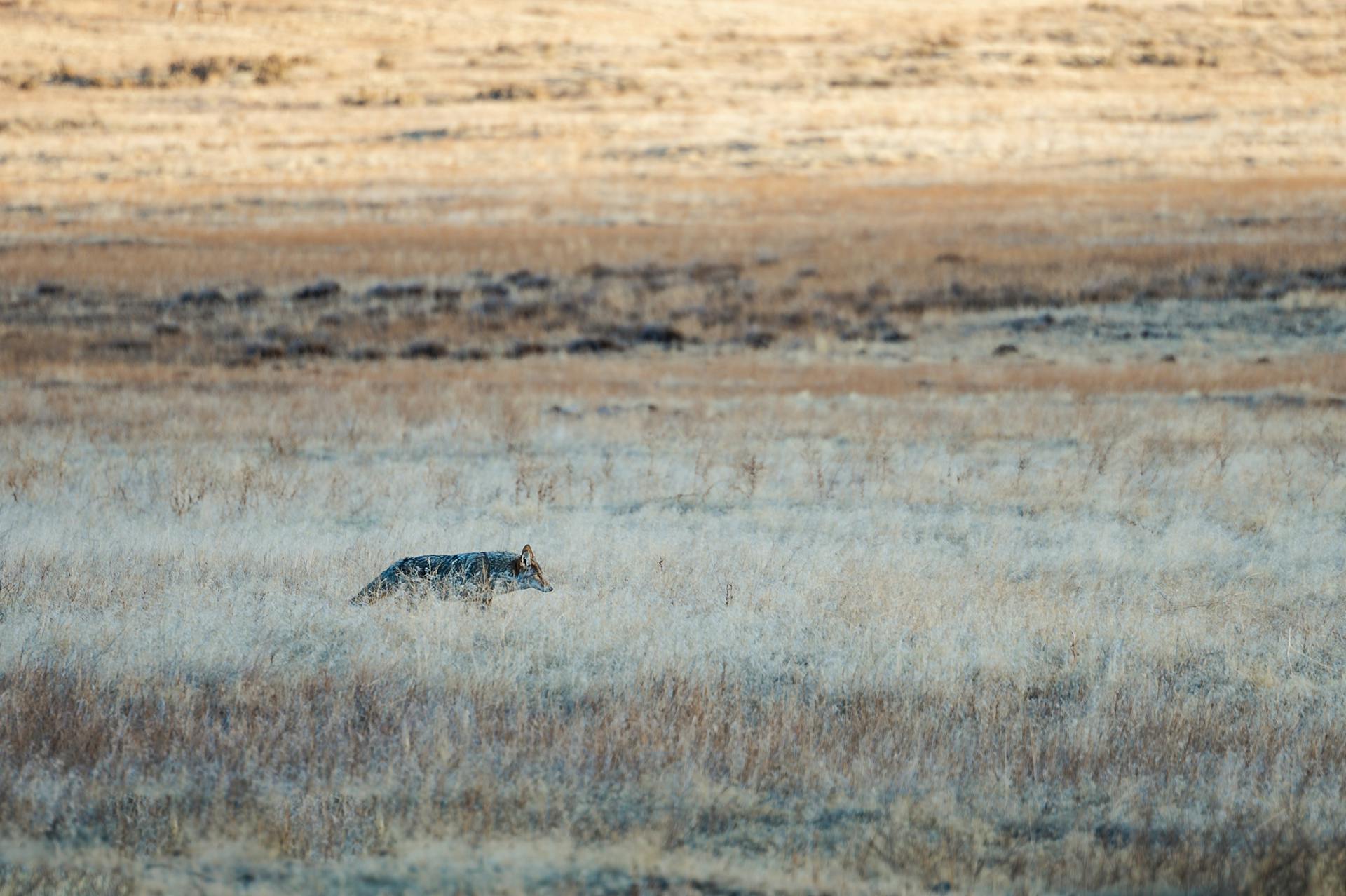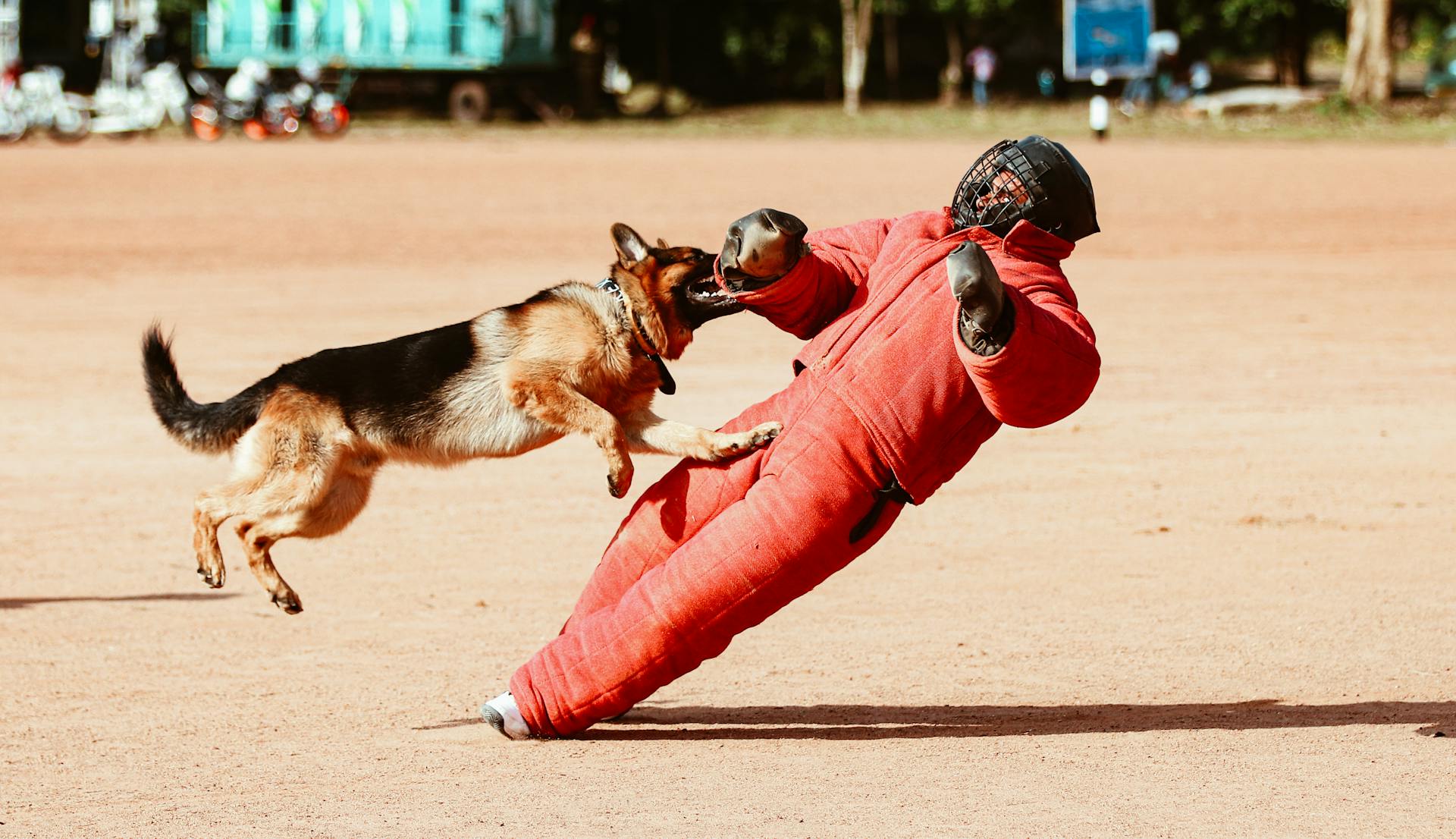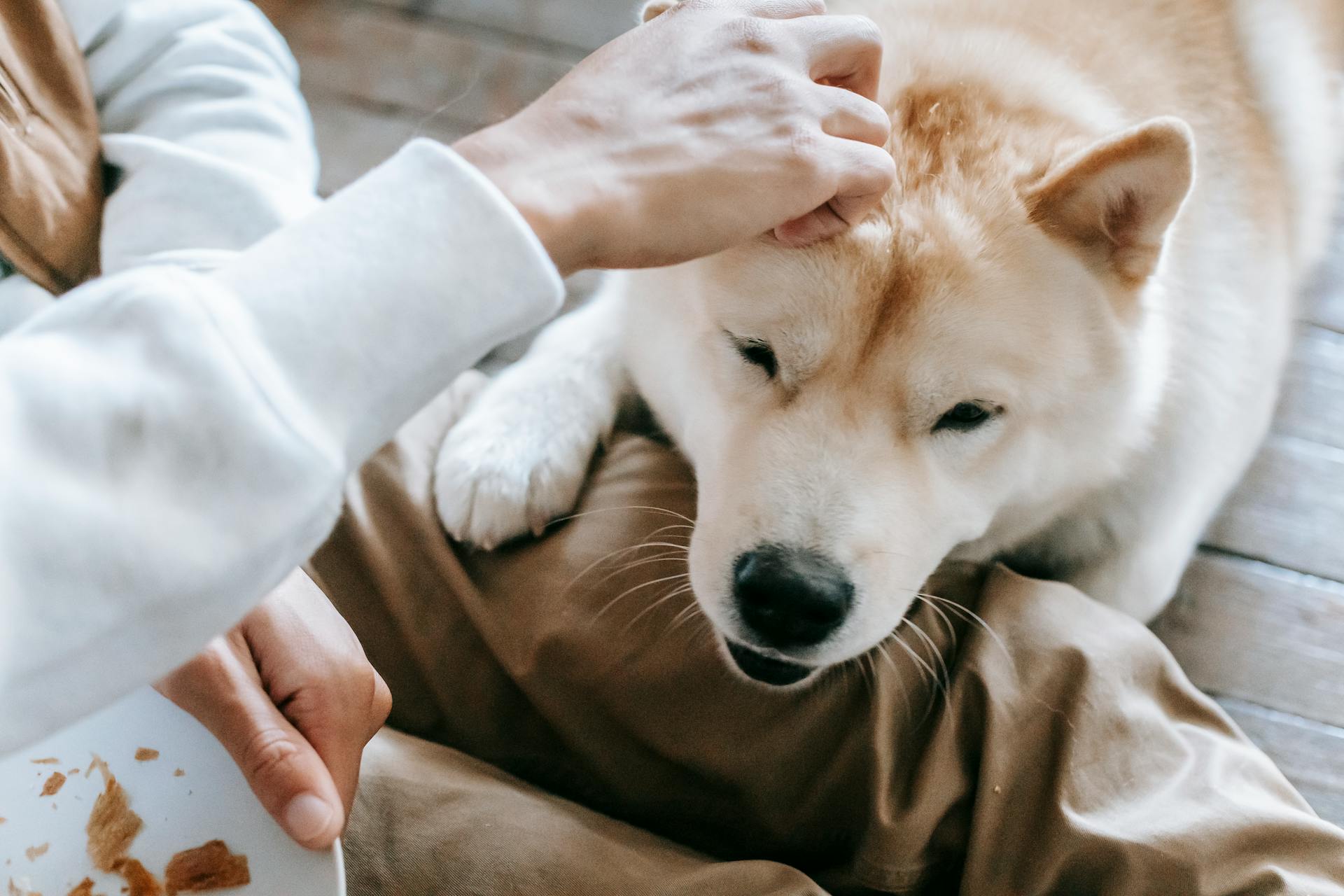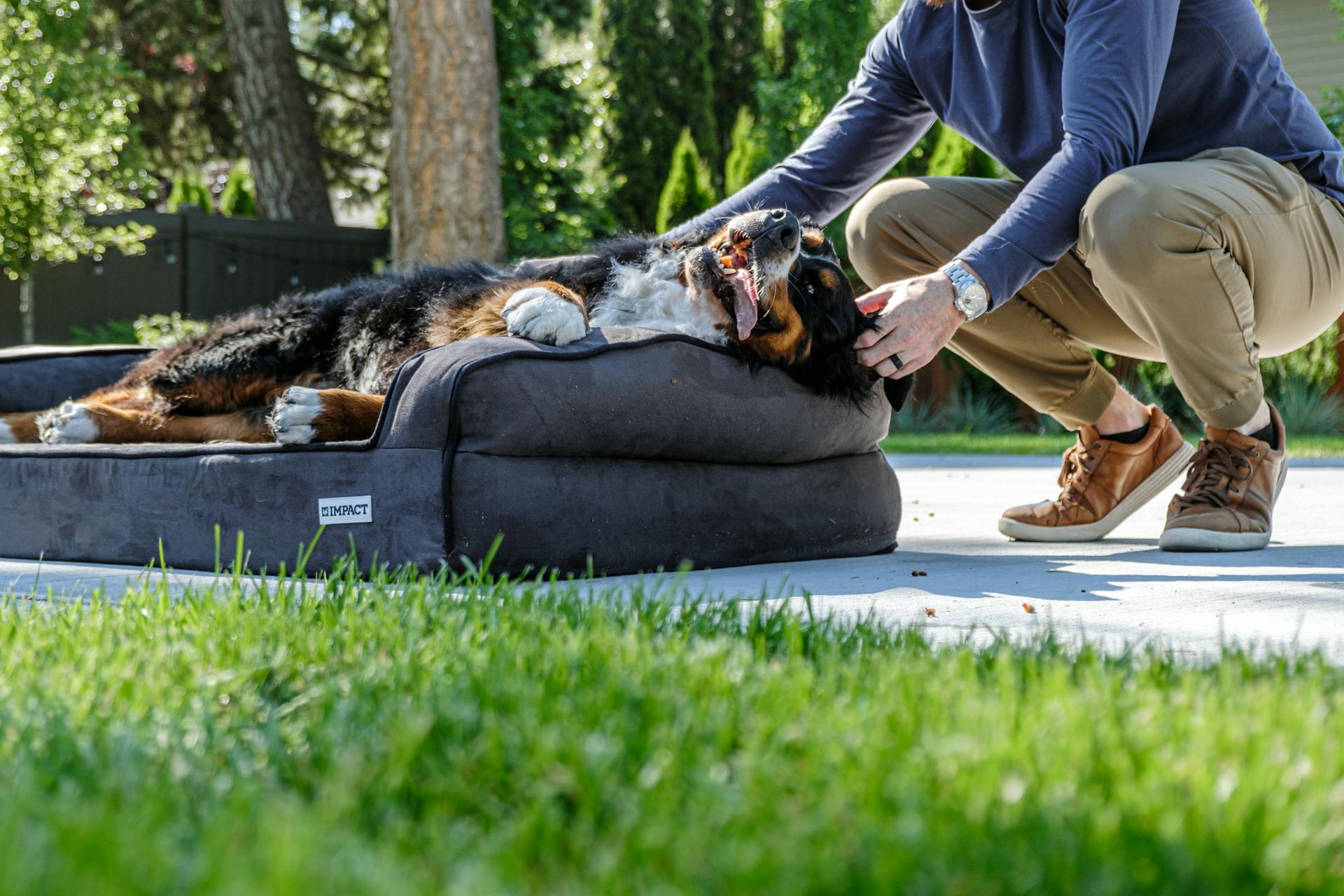
Coyotes are increasingly found in urban areas, and their encounters with dogs are becoming more common. They are attracted to pet food and garbage, which can lead to conflicts with dogs.
Coyotes are generally wary of dogs, but if they feel threatened or if they're protecting their young, they may attack. In fact, coyotes are more likely to attack if they perceive a dog as a threat to their family.
If you live in an area with coyotes, it's essential to take precautions to prevent encounters between your dog and coyotes. Keep your dog on a short leash, especially during coyote mating season, which typically occurs in January and February.
By being aware of coyote behavior and taking preventive measures, you can minimize the risk of an attack.
Curious to learn more? Check out: Dog Attack
Protecting Your Dog
Keeping your dog close to you is key to preventing unwanted coyote encounters. Whether you're walking your dog early in the morning or late at night, make sure to keep them on a leash.
Coyote vests can also provide good protection for small dogs. These vests have a Kevlar neck collar armed with spikes that make it hard for coyotes to get a bite. If you have a small dog, consider investing in a coyote vest.
Training your dog is also crucial in case of coyote attacks. Teach your dog a reliable recall, so they come to you every time you ask. This can save your dog's life in a coyote encounter.
Here are some basic commands to help protect your dog:
- Reliable recall
- Stay command to prevent chasing coyotes
- Heel command to keep your dog by your side
- Emergency U-turn or getting behind you immediately to avoid approaching other dogs
Remember, coyotes can run up to 40 mph, so don't try to outrun them. Instead, put your dog on a leash, keep it short, and make yourself appear larger to scare the coyote away.
Protection on Walks
Keeping your dog close is key to preventing unwanted coyote encounters, especially during early morning or late night walks. This is especially true if you live in an area where coyotes are common.
Coyote vests can be a good option for small dogs, as they have a Kevlar neck collar armed with 1-inch spikes and spikes down the back, making it hard for coyotes to get a bite. These vests were created in 2015 after one family lost their small dog to a coyote.
To protect your dog on walks, keep them on a leash, especially if you're in an area where coyotes frequent. If you're out for a walk and a coyote approaches, your dog's reliable recall can save their life. This means your dog comes to you pretty much every time you ask.
Teaching your dog to ignore distractions and heel can also be helpful on walks. Consider practicing recall games, using positive reinforcement training methods, and adjusting your verbal command if you have a poisoned cue.
See what others are reading: Maltese Small Breed Dogs
People
If you know there are coyotes in your area, keep your dog on leash. This is especially important if you're out with your dog, as coyotes can be attracted to the presence of a dog with a human.
A unique perspective: Scare Coyotes
A male coyote will be attracted to a female dog in heat, and this can lead to unwanted interactions. I had seven howling coyotes on my front lawn when one of my dogs was in heat one time.
Never feed coyotes or otherwise attract them to your yard. They'll go to feral cat colony feeding stations because they're equal opportunity eaters.
In the spring, coyotes are raising their pups and may be aggressive while defending their dens. Stay away from coyote pups.
If you spot a coyote while out with your dog, do not turn and run. That will only attract the coyote.
Dangers to Pets
Coyotes can carry and transmit certain infectious diseases that your dog or other pets can catch. These include distemper, hepatitis, parvovirus, rabies, leptospirosis, and others.
Even if a coyote doesn’t attack your dog, they could still transmit diseases to them if they’re carrying one. These could include anything from mange, fleas, ticks, and worms.
Coyotes can also be a source of mange (mites), fleas, ticks, intestinal worms, and other parasites that they can pass along to your pets. Your dog doesn't even need to come into direct contact with a coyote to pick up these nasty bugs, which is why it's so important to protect your dog year-round with parasite preventatives.
If you have community meetings, you may want to bring up these tips or suggest creating a Facebook group where neighbors can post coyote sightings, so everyone is aware of the potential dangers.
Securing Your Home and Yard
Protect your home and yard by installing coyote-proof fencing that's at least 6 feet tall and buried 18 inches underground, as coyotes are skilled diggers. This type of fencing will prevent them from burrowing under the fence.
Consider adding an overhang on the outside of the fence, which will make it even harder for coyotes to climb over. You can also install coyote rollers, which are aluminum rods that spin when a coyote tries to grip them, preventing them from scaling the fence.
Don't leave your dog outside unsupervised, especially if you don't have good fencing, as this can put them at risk of a coyote attack.
Protecting Your Home
Coyotes can transmit diseases to your pets if they're carrying one, so keep an eye out for signs of illness in your dogs.
These diseases can range from mange and fleas to distemper, rabies, and parvovirus.
Keep your community informed about coyote sightings by suggesting a Facebook group or bringing it up at community meetings.
Regularly inspect your yard for signs of coyote activity, such as tracks, scat, or digging.
Yard Fencing
Securing your yard with the right fencing is a crucial step in protecting your home and family from coyotes. A solid fence that's at least 6 feet tall and buried in the ground at least 18 inches can help prevent coyotes from digging underneath.
You may be wondering what kind of material to use for your fence. Look for something that will stop even the most athletic coyote, such as barbed wire or a tube of PVC pipe. The slick, round shape of PVC pipe is almost impossible for a coyote to grip.
Creating an overhang on the outside of the fence can also be an effective deterrent. This can be done by installing a lip or a ledge that coyotes can't climb over. Coyote rollers, made of aluminum rods, are another option that can spin when a coyote tries to grip them, preventing them from climbing over.
Many homeowners' associations will accept coyote rollers, making them a great solution if you're concerned about aesthetics. They won't make your property look scary, and they're a practical way to keep coyotes out.
Off-Leash Walks in High-Risk Areas
Walking your dog off-leash can be a recipe for disaster in high-risk areas. Coyotes are a major concern, and it's essential to keep your dog close to prevent unwanted encounters.
Most coyotes are afraid of humans, and your presence can often be enough to prevent an attack. If your dog is off-leash, they become a much easier target for coyotes.
In areas where coyote sightings are common, it's crucial to keep your dog on a leash. This can literally save your dog's life.
Fox and Wolf Attacks
Foxes are generally more likely to attack pets, especially small ones, than wolves. They see them as prey.
In areas where wolves are present, it's essential to secure your trash cans to prevent attracting them. Wolves have an excellent sense of smell and can detect food from miles away.
Foxes, on the other hand, are more adaptable to living near humans and can thrive in urban environments. They're also more likely to attack pets if they feel threatened or if they're protecting their young.
Wolves are typically more cautious and will avoid confrontations with humans. However, if they feel their territory is being threatened, they may become aggressive.
Securing your yard by installing a sturdy fence can help prevent fox and wolf attacks on your pets. A fence that's at least 6 feet tall is recommended to keep these predators out.
If this caught your attention, see: Heart Attack
What to Do If You're Followed by a Dog
If you're followed by a dog, stay calm and keep your cool. A dog can run up to 40 mph over short distances, so don't try to outrun it.
If you're walking your dog and a stray dog starts following you, try to stay between your dog and the stray. Put your own dog on a leash, if they aren't already, and keep the leash very short so your dog is right next to you.
Don't turn your back to the stray dog or try to shoo it away yourself. That can make the situation worse. Instead, try to make yourself appear larger and scarier to the stray dog by unzipping your jacket and holding it wide open, or raising your hands above your head and waving them.
If you have a small dog, pick them up and hold them close to you. This will help keep them safe and prevent them from getting into a confrontation with the stray dog.
Here are some additional tips to help you deal with a stray dog:
- Throw rocks or branches towards the stray dog to scare it away (just don't aim directly at it).
- Consider carrying a noise-maker, such as a whistle or a can filled with coins and wrapped in duct tape, to scare the stray dog away.
- If you have a small dog, consider investing in a SpikeVest to protect them in case of an attack.
Frequently Asked Questions
Will a dog scare off a coyote?
Barking may initially pique a coyote's interest, but it's more likely to scare them away once they detect human presence. However, the effectiveness of barking as a deterrent depends on various factors, including the dog's breed, size, and behavior.
Can a dog win a fight against a coyote?
Dogs are unlikely to win a fight against a coyote, except in rare cases where the coyote is old, sick, or the dog is very small
What size dog is safe from a coyote?
Medium-sized dogs are generally safe from coyotes, but smaller breeds may be at risk.
Will coyotes try to eat big dogs?
Coyotes may attack large dogs they view as threats to territory or dens, so it's best to keep them safe indoors.
What time of year do coyotes attack dogs?
Coyotes are more likely to attack dogs during late fall, winter, and early spring. Attacks are less common during the warmer months of the year.
Sources
- https://www.akc.org/expert-advice/health/coyote-attacks-protecting-dogs/
- https://www.whole-dog-journal.com/care/will-coyotes-attack-dogs/
- https://samthedogtrainer.com/articles/why-do-coyotes-foxes-and-wolves-attack-dogs/
- https://www.preventivevet.com/dogs/urban-coyotes-keeping-your-pets-safe
- https://www.dogtales.ca/10-ways-to-protect-your-dog-from-coyotes
Featured Images: pexels.com


